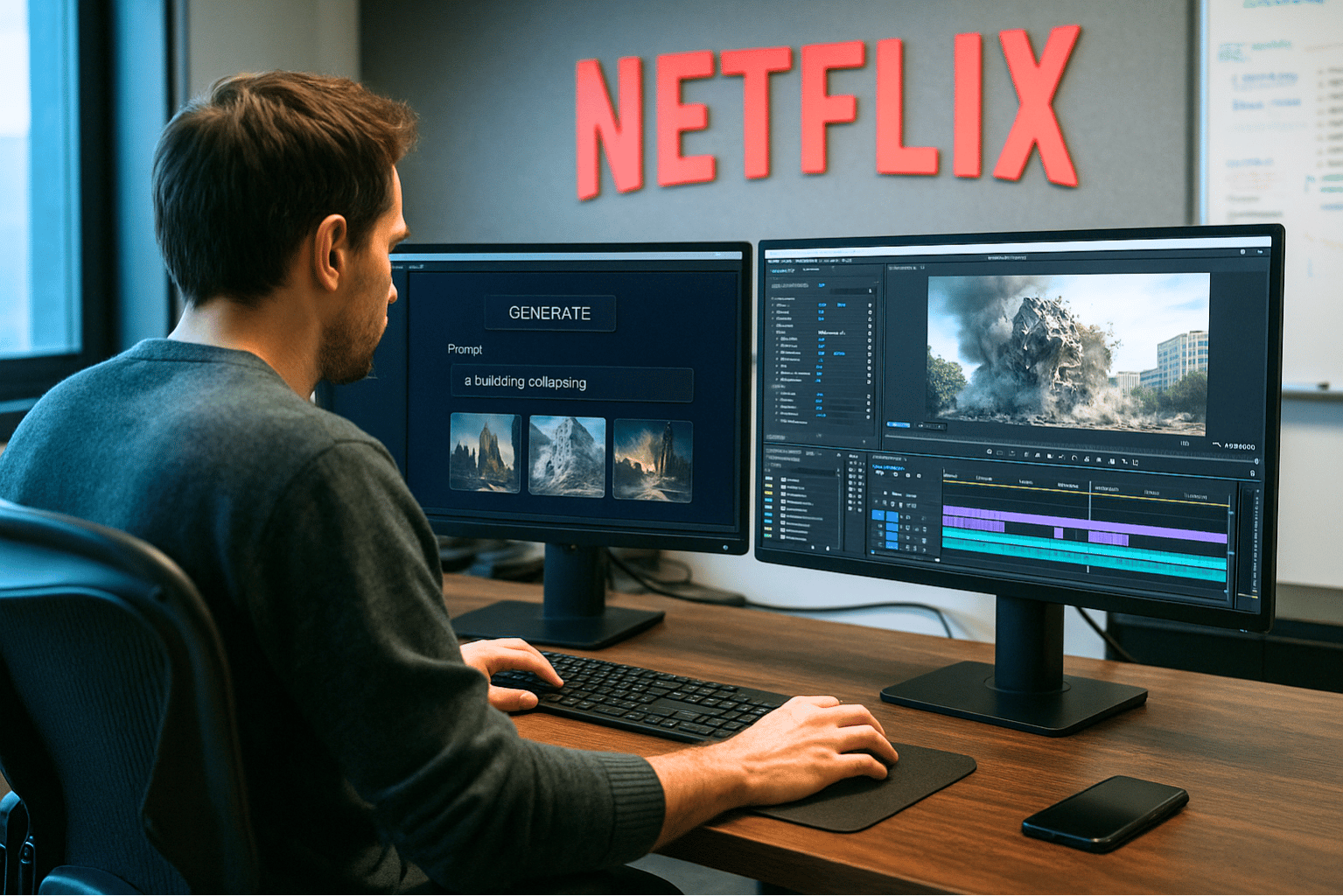
Image Source: ChatGPT-4o
Netflix Begins Using Generative AI in Original Productions
Key Takeaways:
Netflix debuts GenAI final footage in the Argentine series El Eternauta.
AI-assisted VFX scene completed 10x faster using generative tools for a building collapse sequence.
AI powers multiple areas at Netflix, including production, personalization, search, and advertising.
Independent filmmakers use GenAI creatively, with Nik Kleverov and Dave Clark producing fully AI-generated short films.
Netflix Q2 2025 earnings rose 16%, with over 95 billion viewing hours recorded.
Non-English content drives one-third of viewing, showing Netflix’s growing global demand.
Netflix deploys GenAI in scripted content for the first time
Netflix is now actively incorporating generative AI tools into its production workflow, marking a milestone in how the streaming platform develops visual effects for its original programming.
During the company’s Q2 2025 earnings call on Thursday, co-CEO Ted Sarandos announced that Netflix used generative AI to produce final footage in a new scene from El Eternauta, an Argentine sci-fi series. Specifically, AI was used to help generate a sequence depicting a building collapse—a visual effects challenge that would traditionally require significant time and budget.
This is “the very first GenAI final footage to appear on screen,” Sarandos said of the scene. He explained that Netflix’s in-house production team collaborated with the show’s creators to generate the building collapse sequence using AI tools, completing the work ten times faster than traditional VFX methods and at a lower cost.
Sarandos emphasized that AI was not replacing human creators, but augmenting their work with more advanced tools.
“We remain convinced that AI represents an incredible opportunity to help creators make films and series better, not just cheaper. There are AI-powered creator tools. So this is real people doing real work with better tools,” he said. “Our creators are already seeing the benefits in production through pre-visualization and shot-planning work, and certainly visual effects. It used to be that only big-budget projects would have access to advanced visual effects like de-aging.”
Pressed for time?
Scroll down to the Q&A section for quick answers. 👇
AI also expanding across personalization, search, and ads
Co-CEO Greg Peters added that Netflix is also using generative AI to improve personalization and discovery features on the platform, including AI-powered search, which launched earlier this year. Netflix plans to introduce interactive ads in the second half of 2025, powered in part by generative AI systems.
These broader applications point to a company-wide strategy that leverages GenAI not only for content creation but also for enhancing user experience and monetization.
Studio-Scale AI vs. Indie Experiments
Netflix’s use of generative AI reflects a studio-level approach to integrating new tools within established production pipelines. The goal, executives say, is to enhance efficiency and expand access to high-end visual effects—not to reinvent storytelling itself.
By contrast, independent creators like Nik Kleverov and Dave Clark are taking more experimental approaches, using GenAI to produce fully AI-generated short films that often blur the line between animation and live-action. Their projects, built using a mix of video diffusion tools, voice synthesis, and AI editing workflows, aim to test the creative limits of what’s possible without traditional crews or budgets.
These indie films typically feature stylized visuals and narrative frameworks tailored to the quirks of AI generation—whereas Netflix’s strategy is to blend AI seamlessly into conventional formats, with real actors, sets, and production teams still at the core.
Together, these approaches reflect how AI is opening new creative paths across the filmmaking world—and reshaping how stories are made.
Netflix’s Q2 growth reflects global momentum
Netflix reported $11.08 billion in revenue for the second quarter of 2025—a 16% increase compared to the same period last year. The company’s net profit reached $3.13 billion.
Viewing engagement also climbed, with Netflix users collectively watching more than 95 billion hours of content in the first half of 2025. Notably, non-English titles accounted for one-third of total viewing hours, reflecting the platform’s continued expansion into global markets and diverse storytelling formats.
Q&A: How Netflix Uses Generative AI in Film Production
Q: What is Netflix’s first confirmed use of GenAI in production?
A: A building collapse scene in El Eternauta, completed 10x faster using generative AI.
Q: Is Netflix replacing human artists with AI?
A: No. The company says AI is being used as a tool to support creators, not replace them.
Q: What other areas is Netflix using AI for?
A: Personalization, AI-powered search, and upcoming interactive ads.
Q: How are independent filmmakers using generative AI differently?
A: Artists like Nik Kleverov and Dave Clark are using GenAI to create fully AI-generated short films, exploring new formats beyond traditional production.
Q: How did Netflix perform financially in Q2 2025?
A: Revenue hit $11.08B with $3.13B in profit. 95B hours were viewed, one-third from non-English content.
What This Means
Netflix’s adoption of generative AI in scripted content signals a turning point in how large-scale productions may soon operate—compressing timeframes and costs while keeping creative teams in control. While some studios are still testing GenAI in experimental projects, Netflix’s public rollout shows that these tools are already reshaping mainstream production pipelines.
From studio-backed productions to independent experiments, the film industry is entering a phase of rapid exploration—each testing what GenAI can enable, and where the boundaries still lie.
As the company expands its AI strategy into search, personalization, and advertising, its choices may set the tone for how entertainment platforms balance innovation, scale, and creative integrity in the AI era.
Editor’s Note: This article was created by Alicia Shapiro, CMO of AiNews.com, with writing, image, and idea-generation support from ChatGPT, an AI assistant. However, the final perspective and editorial choices are solely Alicia Shapiro’s. Special thanks to ChatGPT for assistance with research and editorial support in crafting this article.
